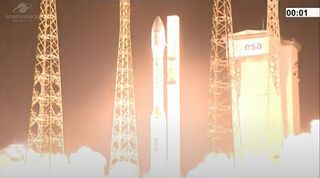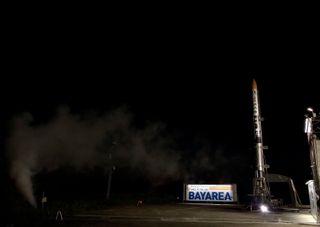To all the rockets we lost in 2020 and what we learned from them
Some were failures and one was an explosive SpaceX success.

Launching rockets is hard. Most of the time we get it right, but sometimes unexpected things happen. Perhaps it's because of a stage failure or perhaps it's because of using a daring prototype, like SpaceX's Starship. But, as devastating as a failure can feel, it can help the teams behind these launches to learn and grow, helping them to continue to improve spaceflight.
Below is a list of the craziest rocket explosions and failures of 2020 (not including situations where a rocket had an anomaly en route but was still able to reach orbit (such as SpaceX's Falcon 9 Starlink rocket launch of March 18) or the numerous launch aborts of 2020 due to situations like weather or technical issues).
Related: The 10 biggest spaceflight stories of 2020
1) Starship SN3 prototype explosion

SpaceX's Starship SN3 was supposed to do a series of tests in the spring that would end with short "hopping" test flights. However, a problem during one of the tests in April caused the prototype to blow up. At the time, SpaceX CEO Elon Musk suggested there may have been a "test configuration mistake" (which was later found to be leaky valves) that led to the vehicle's cryogenic pressure test failing. SpaceX wanted to see if SN3 could withstand the high pressure of super-cold fuel required to send it on flights.
2) Starship SN4 prototype explosion
SpaceX's Starship SN4 prototype also exploded this past May in a dramatic fireball. The explosion happened about one minute after the Raptor rocket engine was tested. That said, SN4 had already lasted through four static-fire engine tests and only ran into problems on its fifth, making it the longest-lived and most-tested Starship at the time. The early testing on SN4 was meant to help with eventual flight readiness for Starship, which took more meaning in the spring after NASA selected Starship as one of the spacecraft to land people on the moon for the agency's Artemis program.
3) Starship SN7 prototype explosion

The next Starship prototype, called SN7, also ruptured during a pressure test in June — a deliberate explosion as SpaceX was testing the limits for the fuel tank. The tank was filled past its capacity with super-chilled liquid nitrogen before bursting. Deliberately pushing parts to failure is a normal part of the spacecraft (and aerospace) industry, because it creates hard data on how far you can push the vehicle during normal operations. In the long term, such testing leads to fewer failures and improved safety.
4) Starship SN8 prototype explosion
The next and last Starship prototype of 2020, named SN8, took to the air for several minutes in December before flipping around and eventually exploding upon landing. While the prototype didn't stick the landing, it did last through several aerial maneuvers, including a "belly flop" similar to what Starship will do during operational flights. CEO Elon Musk appeared elated with the prototype progress, declaring: "Mars, here we come!" in a tweet.
Get the Space.com Newsletter
Breaking space news, the latest updates on rocket launches, skywatching events and more!
5) Northrop Grumman OmegA cancellation
Northrop Grumman was still working on test firing its new OmegA rocket in February, but the program was not planned to last through the year. The company elected to not move forward with the program after the U.S. Space Force didn't include OmegA on its list of potential national security launch contractors, according to Florida Today.
While the OmegA program itself is no more, Northrop Grumman plans to use the lessons learned from this program in other company activities and business lines.
6) Iran's Zafar-1
Iran's communication satellite, Zafar 1, didn't make it to orbit due to a rocket problem during launch in February. The first stage of the launch aboard the Simorgh rocket went to plan, but the satellite didn't pick up enough speed to get in orbit, Defense Ministry space program spokesman Ahmad Hosseini told Iranian state television, according to the Associated Press. Iran had been working through a few rocket failures before this one, including a Simorgh launch failure in January 2019 and another rocket failure (the Safir) in February 2019. Another rocket from Iran appears to have exploded in August 2019, according to satellite footage from San Francisco-based company Planet.
7) China Long March rocket failures
At least two of China's long-running Long March rockets failed during launches in 2020. One failure in March took place with a new version of the rocket, called Long March 7A, which was on its rookie launch.
Weeks later in April, a rocket from the veteran Long March 3B booster line failed to launch an Indonesian satellite. Despite these failures, China did stay active with launching for most of 2020.
8) China's Kuaizhou rocket failures
China's Kuaizhou rocket also had two launch failures in 2020. The first problem took place in July, when a Kuaizhou-11 rocket (on the first-ever flight for that rocket type) failed after appearing to successfully launch and separate its first and second stages. Later in September, a Kuaizhou-1A rocket also experienced a problem during launch, according to SpaceNews. On both occasions, China briefly acknowledged the failure publicly and said the cause would be investigated.
9) Virgin Orbit's LauncherOne
Virgin Orbit had a problem during its test flight of the LauncherOne rocket, which failed to separate from its carrier plane, in May. The California-based company successfully performed several test flights before releasing the rocket on a failed effort to take a dummy payload to low Earth orbit. Virgin Orbit later said an anomaly of LauncherOne's NewtonThree engine caused the problem.
Virgin Orbit is now planning a new test launch called Demo 2, which will carry 10 CubeSats aloft; the mission has been delayed indefinitely from its December launch date due to the coronavirus pandemic reducing staffing levels, Virgin Orbit said on Twitter in December.
10) Rocket Lab's Electron
New Zealand-based company Rocket Lab had a problem with the second stage of an Electron rocket in July that led to the loss of all seven small satellites aboard. Within weeks, Rocket Lab finished its investigation and said the failure happened due to a single faulty electrical connection in the rocket's upper stage.
The company recovered and successfully finished four more launches in 2020, closing out the year with the launch of a Japanese Earth-imaging satellite in December.
11) Astra's first orbital test flight
California-based startup Astra experienced a problem during what was supposed to be its first orbital mission. The booster lifted off successfully, but the rocket's guidance failed during the firing of its first stage, Astra said in September.
The company reached space successfully during a second test flight in December, but failed to reach orbit because the upper stage of Rocket 3.2 wasn't going quite fast enough. Following a few more engineering adjustments, Astra plans to send its first paying flight into space in 2021.
12) Arianespace's Vega

Arianespace saw the second failure of its Vega rocket in November, when its booster failed to bring satellites for Spain and France into orbit. The rocket ignited its upper stage, Avum, but the booster veered off course roughly eight minutes into flight and lost contact with ground stations.
Arianespace said the likely cause was "a problem related to the integration of the fourth-stage AVUM nozzle activation system is the most likely cause of the loss of control of the launcher." The investigation is ongoing and Vega's return-to-flight date has not yet been announced.
13) Japan's Interstellar Technologies

Private Japanese company Interstellar Technologies had an issue with its Momo-F5 sounding rocket that caused it to crash shortly after ignition in June. The crowdfunded rocket had an anomaly that forced Interstellar Technologies to send an abort command 70 seconds after launch, and the rocket crashed into the Pacific Ocean.
The maximum altitude of 7.1 miles (11.5 kilometers) during the mission was well short of its goal of 62 miles (100 km), an internationally recognized boundary of space.
Follow Elizabeth Howell on Twitter @howellspace. Follow us on Twitter @Spacedotcom and on Facebook.
Join our Space Forums to keep talking space on the latest missions, night sky and more! And if you have a news tip, correction or comment, let us know at: community@space.com.

Elizabeth Howell (she/her), Ph.D., is a staff writer in the spaceflight channel since 2022 covering diversity, education and gaming as well. She was contributing writer for Space.com for 10 years before joining full-time. Elizabeth's reporting includes multiple exclusives with the White House and Office of the Vice-President of the United States, an exclusive conversation with aspiring space tourist (and NSYNC bassist) Lance Bass, speaking several times with the International Space Station, witnessing five human spaceflight launches on two continents, flying parabolic, working inside a spacesuit, and participating in a simulated Mars mission. Her latest book, "Why Am I Taller?", is co-written with astronaut Dave Williams. Elizabeth holds a Ph.D. and M.Sc. in Space Studies from the University of North Dakota, a Bachelor of Journalism from Canada's Carleton University and a Bachelor of History from Canada's Athabasca University. Elizabeth is also a post-secondary instructor in communications and science at several institutions since 2015; her experience includes developing and teaching an astronomy course at Canada's Algonquin College (with Indigenous content as well) to more than 1,000 students since 2020. Elizabeth first got interested in space after watching the movie Apollo 13 in 1996, and still wants to be an astronaut someday. Mastodon: https://qoto.org/@howellspace
